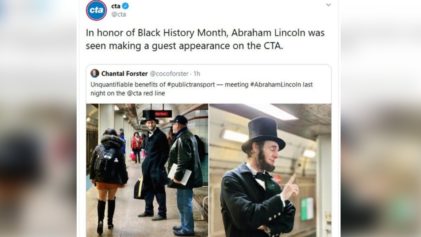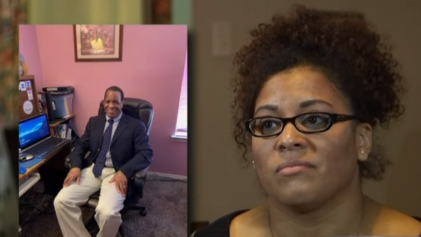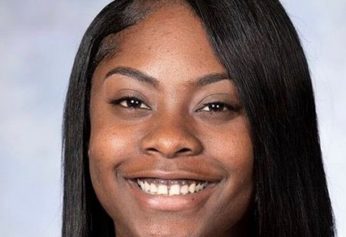
Girls promoting the Stand for Something Movement during the Baltimore Ceasefire. (Courtesy: Twitter @angela_empowers)
Baltimore is in the midst of a record wave of gun violence. Following a recent call for a weekend ceasefire from August 5 to August 7 in response to the high rate of firearm homicides, the Baltimore Ceasefire — coordinated by community mediator Erricka Bridgeford and organized on social media under the hashtag #BaltimoreCeasefire — ended with six shootings and two fatalities.
“Over the years, I’ve lost a brother, a stepson and had cousins who were killed,” Bridgeford said to Essence. Bridgeford avowed that the homicides did not take away from the call for peace. “I was in the car with my son talking about the murder rate being higher than ever and saying `Why won’t somebody do something?!’ But my parents didn’t raise me to be a complainer. I reached out to people with street credibility and we started working.”
Baltimore has seen 204 homicides in just the first seven months of the year. Per capita, this makes Baltimore the deadliest city in the United States and second only to Chicago in absolute numbers. For the residents of Baltimore, this spike of violence is having significant effects, particularly on the children.
“They are so numb. This is so normal. That is why it continues,” Ericka Alston-Buck said to the Baltimore Sun about how gun violence has made the community’s children become inured. “You’ll hear a 6-year-old say, ‘So-and-so got shot.’ That’s normal. They’ll hear gunshots and say, ‘Someone’s shooting,’ but they’re not ducking for cover. It’s normal.”
Baltimore’s gun violence spike comes following the police-involved death of Freddie Gray in 2015, where Gray died in police custody from spinal trauma. The death and subsequent acquittals and dismissals of cases brought against six officers have left the city’s Black community on edge and disdainful of the police, which may be fueling the violence epidemic.
While the size of the gun violence problem is unique to Baltimore, the nature of it is not. this despite crime levels nationwide remaining low. Understanding why this is so can help to point out not only who are the winners — if there are any — and losers in this strife, but also why finding a solution for this problem may take more than simply adding more police to the streets.
“We are a city that is under siege, as are so many areas of our country,” Karsonya Wise Whitehead, associate professor of communication and African and African American studies at Loyola University Maryland and Baltimore city commissioner for the Community Relations Commission, wrote in an editorial for the Baltimore Sun. “We now see the impact of what happens to a nation when three generations of black males are incarcerated and or marginalized by an inadequate educational system. We now see what happens when people are forced to live in food deserts, when police brutality goes unchecked, when society is socialized to see the black body as dangerous and criminal. And yes, when young black people living in the inner city put their trust and their hope in weapons and violence; we reap what we sow.”
Understanding the Causes of the Crisis
Opioids: To understand what is afflicting Baltimore, it is important to look at underlying factors. In 2016, more than twice as many Baltimoreans died from drug overdoses than from homicides. In a city where roughly ten percent of the population is addicted to heroin, per the city’s health commissioner, Baltimore is the most addicted big city (city with a population over 250,000) in the United States.
While opioid addiction is nothing new for Maryland, last year saw a 66 percent increase statewide in fatal alcohol and drug-related overdoses from 2015. Baltimore accounts for approximately a third of the state’s numbers.
Opioids are a class of painkilling drugs that include heroin, fentanyl, codeine, morphine, hydrocodone (Vicodin) and oxycodone (OxyContin). Due to their euphoric effects and high potency, these drugs are highly addictive.
With estimates pegging opioid use in the United States as pervasive enough for nearly every adult American to have a prescription for painkillers, the ease in getting opioids, the opioid epidemic — fueled in part by the long-term denial of the medicine’s harm by the pharmaceutical companies and aggressive marketing — has affected every corner of the country. However, opioid use, especially in Baltimore, tends to be a learned habit, passed from generation to generation.
“It’s an old ‘heroin town,'” Tom Carr, the director of the Washington/Baltimore HIDTA program, said to ABCNews. “There is an appetite for heroin in Baltimore, … It’s accepted by all too many people down there as something that’s normal behavior.”
In June, suspicion of gang involvement in a recent string of shootings led Baltimore police to put all officers on the streets on 12-hour shifts for a week. While some of the violence is related to drug trafficking, some is blamed on retaliatory violence among members of the Black Guerrilla Family and Bloods.
Police Commissioner Kevin Davis told the Baltimore Sun gun offenders have no fear of the legal system. Under the system that exists today, gun offenders in Baltimore, Davis said, “Do not fear an arrest, they do not fear a successful prosecution, and, quite frankly, they don’t even fear a damn guilty verdict,” because they often receive minimum sentences.
Police data reveals a reduction in policing in the areas hardest hit by the upswing in violence — such as a decline in arrests in the Sandtown-Winchester neighborhood from May 2015 to March 2017 of 47 percent — despite an increase in gun homicides.
“When persons do not trust the police to act on their behalf and to treat them fairly and with respect, they lose confidence in the formal apparatus of social control and become more likely to take matters into their own hands,” a 2015 U.S. Department of Justice report reads. “Interpersonal disputes are settled informally and often violently. Honor codes develop that encourage people to respond with violence to threats and disrespect.”
Distrust of the police and local government: In 2016, the Justice Department found that the Baltimore Police Department’s “zero tolerance” street enforcement led to an excessive amount of unconstitutional stops, searches, and arrests — typically, resorting to force — done with minimal training and oversight. In a six-year period, the Baltimore Police Department used force a reported 2,818 times. Of these 2,818 times, only ten were flagged for investigation, with only one being found to be excessive force.
Among the police offenses the report found were:
- A woman with a broken headlight stopped and publicly strip-searched;
- An officer not reporting a colleague for planting drugs due to fear of retaliation;
- The Baltimore Police Department declining to classify the word n**ger as a racial slur, with officers being accused of using the word more than sixty times;
- An officer using a Taser on a swearing man, saying that the man’s “mouth” was his “weapon”;
- Officers discrediting victims of sexual assault by putting the blame on them;
- A sergeant telling an officer to “make something up” to justify a stop;
- Trespass arrest forms with “black male” pre-filled;
- An officer that shot a person fatally in 2013 was only interviewed for five minutes, with internal affairs investigators allowing “pre-interviews” so that officers can practice what they say on the record;
- A single officer receiving 125 complaints in just a few years without being investigated; and
- Police officers admitting to stopping people without probable cause.
This report justified what many in the Baltimore Black community have suspected for years. The lack of convictions of the officers involved in the Freddie Gray death reinforced the “them vs. us” mentality that is perceived by both the members of the police department and the Black community. However, with doubts that the Trump administration’s Justice Department will follow through with the consent decree that the findings recommend, the Black community may be rightfully concerned about the possibility of reform in the current political atmosphere.
The Realities of Poverty
These underpinning causes all point to a singular root of Baltimore’s problems. “This crisis did not just happen overnight,” Brenda Bailey, a Baltimore city resident and owner of Baltimore’s Baileys Boutique, said to Atlanta Black Star. “What we are seeing is a result of years of neglect and suppression. The violence is just a symptom of the underlying disease.
“What is that disease, you may ask? Systematic communal self-genocide. The destruction we are now witnessing is the product of neglect and misrepresentation. Baltimore communities have gradually had progressive advancement opportunities stripped from them to the point where there is nothing left for its citizens but ‘every man for himself.’ When your back is against the wall, when all deals are off the table, how do you survive?”
A look at where the gun violence is occurring speaks to the causations behind the shootings. In Baltimore, approximately 80 percent of gun homicides happen in about 25 percent of the city’s neighborhoods. Heavily abandoned and economically depressed neighborhoods like Coldstream Homestead Montebello, Sandtown-Winchester (which is the site of Freddie Gray’s arrest), and Berea have borne the majority of the city’s shootings. These neighborhoods are largely populated by poor African-American residents and are held mostly by the gangs.
These neighborhoods also demonstrate severe economic disparity. Opportunity Nation is a bipartisan, national coalition of more than 350 organizations that are working together to close the opportunity gap in the United States. Opportunity Nation launched its Opportunity Index, which measures the opportunities available for residents in various regions. According to the Opportunity Index, Maryland ranks sixth in regards to growth opportunities among the states. Maryland has an unemployment rate, median household income, and percentage of residents above the poverty line all superior to the national average.
However, when one boils down the details, a disturbing pattern emerges. Baltimore City has an unemployment rate, for example, that is two percent higher than the state’s average. The city also has a median household income that is nearly $30,000 less than the state’s average and a percentage of the population living below the poverty line that is more than double the state’s. In Sandtown-Winchester, 51.8 percent of the population 16 to 64 was not employed as of 2015. Some 49.3 percent of ninth- to 12th-graders were chronically absent from school, 60.7 percent of the population 25 years old or older had less than a high school diploma, and 33.1 percent of all residences were abandoned or vacant.
In light of such realities, many of those that are resorting to gun violence may be responding to what seems to be an untenable situation.
“At the rate we are now going, discontentment with the Baltimore Police and the city/state government is on a steady incline and will continue to increase if things do not change,” the boutique owner Bailey continued. “However, socioeconomic disparity can be considered a foundational focal point. If similar opportunities were afforded across the board regardless of race, a drastic climate change would take place within Baltimore. When you revoke access to fundamental programming and resources, you open the door for infectious behavior.
Winners and Losers
Baltimore is a city that never truly recovered from the Great Recession. Blighted by the industrial downturn of the 1990s, Black wealth in Baltimore took a hit during the housing market crash. As African-Americans typically hold wealth in their homes, Baltimore’s large number of foreclosures — the ninth largest in the nation as of 2015 — left Baltimore economically depressed.
Any discussion regarding how to solve the gun violence problem in Baltimore must start by addressing the socioeconomic disparities the Black community face, including uneven policing, lack of economic development and educational opportunities, and a breakdown of the community’s infrastructure.
In this struggle where everyone seems to be the loser, one must ask who benefits from keeping this situation the way it is? It can be argued that those seeking to gentrify Baltimore City may have something to gain in this. However, as Baltimore’s problems are the same as those faced in many other large cities, the ones that truly benefit from Baltimore’s gun violence are those that can use it to gloss over the city’s disparity problems.
With many taking the president’s lead in saying that the problem with the major cities is violence and not attainment, addressing the problem becomes a matter of simply adding more police and taking a more aggressive stance against crime. Doing this may only inflame the problem, leading to seemingly endless waves of destruction.
“We are a city that is in deep mourning; we are a city that is deeply troubled,” Karsonya Wise Whitehead added. “Baltimore City is in the midst of a war, and many of its residents are suffering from PTSD. Some of the symptoms include physical pain, like headaches, fatigue or chest pain; negative changes in beliefs and feelings, where you begin to believe that the world is completely dangerous and no one can be trusted; or developing a sense of hyperarousal, where you are always alert and on the lookout for danger.
“This describes how I feel almost every day in this city, and it makes sense as our homicide numbers are higher than in New York City, which has a population almost 14 times the size of ours, and our homicide rate is more than double Chicago’s. Homicide has become our way of life. It is no longer shocking nor surprising. It is to be expected in this never ending cycle of violence, failed solutions, fear and distrust.”


